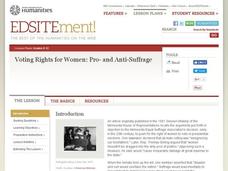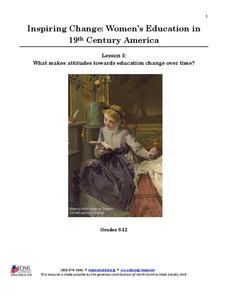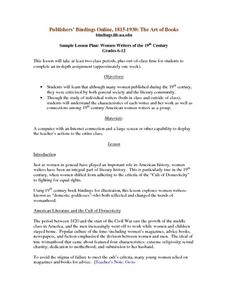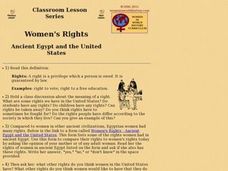C3 Teachers
Women’s Rights: What Does It Mean to Be Equal?
A guided-inquiry lesson asks seventh graders to research the compelling question, "What does it mean to be equal?" Guided by three supporting questions, researchers complete three formative performance tasks and gather evidence from...
Curated OER
Voting Rights for Women: Pro- and Anti-Suffrage
Students examine the arguments for and against suffrage for women in the 19th and early 20th centuries. They explore various websites, read and discuss primary source documents, develop a document from two points of view, and analyze...
Curated OER
African American Women Before and After the Civil War: Slavery and Freedom
Learners listen to data on African American women in Texas before the Civil War. In this Civil War lesson, students compare and contrast the lives of slave and free women, and discuss case studies, locating areas on a map. Learners...
National Endowment for the Humanities
Women's Lives Before the Civil War
Women's lifestyles before the Civil War made a huge impact as a point of causation. Give middle schoolers the opportunity to view firsthand the lives of women before the Civil War. They analyze primary source documents, view photographs,...
National Woman's History Museum
Inventive Women - Part 2
The Declaration of Independence was published in 1776. The Declaration of Sentiments and Resolutions, modeled after the Declaration of Independence, was drafted and read by Elizabeth Cady Stanton at the Seneca Falls Convention in 1848....
National Woman's History Museum
Inventive Women - Part 1
While a woman didn't invent the parasol, three women received patents for their improvements to the original design of umbrellas. In the first of a two-part series on inventive women, class members investigate the patent system to...
National Society Daughters of the American Revolution
Lesson 3: What Makes Attitudes Towards Education Change over Time?
The struggle for women's rights is not unique to this generation, or even to the 20th century. Class members explore the conflicting opinions of Alexander Graham Bell and his wife, Mabel Hubbard Bell, regarding women's pursuits of higher...
Curated OER
Women's Rights and Reform
Students evaluate primary source documents. They assess the development of women's rights in the United States. They identify other rights beside suffrage that were important to famous women reformers.
Curated OER
Women's Rights Historic Sites
Students use maps, readings, floor plans, photos and cartoons to research the conditions of upstate New York in the first half of the 19th century, examine the issues that led to Women's Rights Convention of 1848 and consider current...
Curated OER
19th Century Women's Suffrage - Sheltered Activities
Students reenact The USA v. Susan B. Anthony and discuss women's suffrage and the 19th Amendment.
Curated OER
Women’s History
Students examine the "Cult of Domesticity." In this women's history instructional activity, students visit the specified Web sites to engage in research related to the characteristics that were thought to represent true womanhood as well...
Curated OER
Introduction to Reform Movements of the 1800s
Eleventh graders consider the impact of reform movements of the 19th century. In this Progressive Reform lesson plan, 11th graders examine documents and images associated with women's suffrage, prohibition, and labor reform. Students...
Curated OER
Reforms of the Mid-1800's
Seventh graders complete a unit of lessons on the reform movements of the mid-1800's in the U.S. They participate in an Internet scavenger hunt, analyze primary source documents, and develop and perform a simulation of a mid-19th century...
Curated OER
Dress Reform in the 19th Century
Students read and discuss the writings of Elizabeth Cady Stanton, Timothy Shay Arthur and others to explore mid to late 19th century dress reform. They use their findings to write a letter to an editor from a 19th century viewpoint.
Curated OER
How Women Won the Right to Vote
Students consider how women gained the right to vote in America. In this suffrage lesson, students investigate major events of the suffrage movement and conduct research. Students also role play petitioning to President Wilson to get the...
NPR
Progressive Era Lesson Plan
The women working for equal rights in the early 20th century weren't a part of one large group; rather, they were members of dozens of small groups focused on social reform. Explore the ways groups in the Progressive Era like National...
Curated OER
Writers of the 19th Century
Learners are introduced to women authors during the 19th century. In groups, they read about the criticism they faced during this time period by the public and literary community. Using the internet, they research one author to...
Daughters of the American Revolution
Lesson 1: How Do Society’s Expectations Influence Education?
The history of women's education can be traced back to the delicate stitching of student samplers from the 19th century. Modern-day pupils examine and analyze four primary sources, three of which are images of embroidered samplers, which...
Curated OER
Sojourner Truth, African American Woman of the 19th Century
Students examine Sojourner Truth's philanthropist acts during her life. They discover that everyone has the right to be heard by their government. They compare and contrast the woman's movement and the anti-slavery movement.
Curated OER
Women's History Week
Young scholars investigate the contributions of women who influenced human rights in US history. They examine the influence Susan B. Anthony, Harriet Tubman, Sojourner Truth and Elizabeth Cady Stanton by participating in a jigsaw...
Curated OER
Cultural and Social Transformation since 1865
High schoolers research the evolution of cultural and social issues in areas of Westward Expansion, Immigration, and Civil Rights. They practice writing clear details with supporting evidence and examples and evaluate ways of improving...
Curated OER
Women's Rights Ancient Egypt and the United States
Students explore the rights of women in the United States and ancient Egypt. Comparisons between the two eras and countries are made as the wealth, business, marriages, court cases, divorces, and employment of women are probed.
Curated OER
Elizabeth Cady Stanton, Suffragist
Students examine one woman's impact on a nation. In this suffragette lesson, students are introduced to Elizabeth Cady Stanton and examine her involvement in both the anti-slavery and woman's movement. Students compare the Declaration...
Curated OER
African Americans and the Move West
Students examine the phases of westward migration in the United States during the 19th century focusing on the incentives that led many African Americans to make the move.

























